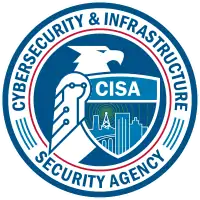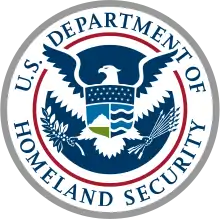Cybersecurity and Infrastructure Security Agency
The Cybersecurity and Infrastructure Security Agency (CISA) is a standalone United States federal agency, an operational component under Department of Homeland Security (DHS) oversight.[2] Its activities are a continuation of the National Protection and Programs Directorate (NPPD). The CISA was established on November 16, 2018 when President Donald Trump signed into law the Cybersecurity and Infrastructure Security Agency Act of 2018.[3][2]
 | |
| Agency overview | |
|---|---|
| Formed | 2018 |
| Jurisdiction | United States |
| Headquarters | Rosslyn, Arlington, Virginia |
| Employees | 3,374 (2017)[lower-alpha 1] |
| Annual budget | $3.16 billion (2020) |
| Agency executives |
|
| Parent agency | Department of Homeland Security |
| Website | DHS Cybersecurity and Infrastructure Security Agency |
Former NPPD Under-Secretary Christopher Krebs was CISA's first Director, and former Deputy Under-Secretary Matthew Travis was its first Deputy Director.[4][5] The expected role of CISA is to improve cybersecurity across all levels of government, coordinate cybersecurity programs with states, and improve the government's cybersecurity protections against private and nation-state hackers.[2]
History
Formed in 2007, the National Protection and Programs Directorate (NPPD) was a component of the United States Department of Homeland Security.[6] NPPD's goal was to advance the Department's national security mission by reducing and eliminating threats to U.S. critical physical and cyber infrastructure.
On November 16, 2018, President Trump signed into law the Cybersecurity and Infrastructure Security Agency Act of 2018, which elevated the mission of the former NPPD within DHS, establishing the Cybersecurity and Infrastructure Security Agency (CISA).[7] CISA is a successor agency to NPPD, and assists both other government agencies and private sector organizations in addressing cybersecurity issues.[8]
On January 22, 2019, CISA issued its first Emergency Directive (19-01: Mitigate DNS Infrastructure Tampering)[9] warning that "an active attacker is targeting government organizations" using DNS spoofing techniques to perform man-in-the-middle attacks.[10] Research group FireEye stated that "initial research suggests the actor or actors responsible have a nexus to Iran."[11]
In 2020, CISA created a website, titled Rumor Control, to rebut disinformation associated with the 2020 United States presidential election.[12] On November 12, 2020, CISA issued a press release asserting, "There is no evidence that any voting system deleted or lost votes, changed votes, or was in any way compromised."[13] On the same day, Director Krebs indicated that he expected to be dismissed from his post by the Trump administration.[14] Krebs was subsequently fired by President Trump on November 17, 2020 via tweet for his comments regarding the security of the election.[15]
Bryan Ware, assistant director at CISA, submitted his resignation on November 12 as well, with reports that his resignation had been requested.[16][14]
Role
An October, 2020 review in the Institute for World Politics student journal Active Measures stated that CISA apparently lacks an enforcement division.[17] The Federal Protective Service, which resorted until 2010 under U.S. Immigration and Customs Enforcement, was moved in May 2019 from CISA to the DHS Management Directorate.[18]
Performance
On 17 December 2020, it was revealed that several US agencies had been hit by a massive months-long intrusion by overseas hackers.[19]
Subcomponents

CISA subcomponents include the:[20]
- Cybersecurity Division
- Infrastructure Security Division
- Emergency Communications Division
- National Risk Management Center
- Integrated Operations Division
- Stakeholder Engagement Division
- National Emergency Technology Guard (inactive, but can be activated by the director of CISA)
References
- "Leadership". US Department of Homeland Security.
- Cimpanu, Catalin (November 16, 2018). "Trump signs bill that creates the Cybersecurity and Infrastructure Security Agency". ZDNet. Archived from the original on February 19, 2019. Retrieved December 16, 2018.
- "About CISA". Department of Homeland Security. November 19, 2018. Archived from the original on July 6, 2019. Retrieved December 16, 2018.
 This article incorporates text from this source, which is in the public domain.
This article incorporates text from this source, which is in the public domain. - Johnson, Derek B. (March 18, 2018). "NPPD taps vendor for No. 2 role". Federal Computer Week. Archived from the original on September 30, 2019. Retrieved March 15, 2019.
- Rockwell, Mark (December 20, 2018). "Standing up CISA". Federal Computer Week. Archived from the original on September 30, 2019. Retrieved March 15, 2019.
- "DHS | About the National Protection and Programs Directorate". Dhs.gov. August 26, 2011. Archived from the original on September 25, 2011. Retrieved September 27, 2011.
- "Cybersecurity and Infrastructure Security Agency". DHS.gov. Archived from the original on November 23, 2018. Retrieved November 24, 2018.
- Ropek, Lucas (July 28, 2020). "Will CISA Be the Savior of State and Local Cybersecurity?". Government Technology. Retrieved November 18, 2020.
- "Emergency Directive 19-01". cyber.dhs.gov. Department of Homeland Security. Archived from the original on July 3, 2019. Retrieved February 16, 2019.
- Krebs, Christopher. "Why CISA issued our first Emergency Directive". cyber.dhs.gov. Department of Homeland Security. Archived from the original on July 6, 2019. Retrieved February 16, 2019.
- Hirani, Muks; Jones, Sarah; Read, Ben. "Global DNS Hijacking Campaign: DNS Record Manipulation at Scale". FireEye. Archived from the original on June 25, 2019. Retrieved February 16, 2019.
- Courtney, Shaun; Sebenius, Alysa; Wadhams, Nick (November 12, 2020). "Turmoil Hits Cyber Agency Engaged in Election as Staff Leave". Bloomberg News. Retrieved November 18, 2020.
- "Federal cybersecurity agency calls election 'most secure in American history'". Engadget. Retrieved November 17, 2020.
- Geller, Eric; Bertrand, Natasha. "Top cyber official expecting to be fired as White House frustrations hit agency protecting elections". Politico. Retrieved November 13, 2020.
- Kaitlan Collins and Paul LeBlanc. "Trump fires director of Homeland Security agency who had rejected President's election conspiracy theories". CNN. Retrieved November 18, 2020.
- "Top US cybersecurity official reportedly says he expects to be fired". The Guardian. November 12, 2020. Retrieved November 13, 2020.
- Atkinson, Wade H., Jr (October 22, 2020). "A Review of the Trump Administration's National Cyber Strategy: Need for Renewal and Rethinking of the Public-Private Partnership in U.S. National Security Policy". Active Measures, A Student Journal of The Institute of World Politics. The Institute of World Politics. Retrieved December 16, 2020.
Presumably, the new Cybersecurity and Infrastructure Security Agency will streamline the functions of the old NPPD. However, as envisioned, it still lacks a Division of Enforcement, similar to the Divisions of Enforcement of the SEC, CFTC, or FTC to serve as an investigatory/enforcement/international-information-sharing arm to enforce the 11 cybersecurity statutes Congress passed in 2014 and 2015. Therefore, the Cybersecurity and Infrastructure Security Agency will apparently have to rely on cooperation and information-sharing, rather than administrative enforcement, and refer civil, administrative, and criminal cases to the Department of Justice (DOJ).
- Rectanus, Lori (June 11, 2019). "Federal Protective Service's Organizational Placement: Considerations for Transition to the DHS Management Directorate, Statement of Lori Rectanus Director, Physical Infrastructure, Testimony Before the Subcommittee on Oversight, Management and Accountability, Committee on Homeland Security, House of Representatives" (PDF). United States: Government Accountability Office. Retrieved December 16, 2020.
- https://www.nbcnews.com/news/us-news/department-energy-says-it-was-hacked-suspected-russian-campaign-n1251630
- "Cybersecurity and Infrastructure Security Agency Organizational Chart". Department of Homeland Security. February 27, 2019. Archived from the original on April 17, 2019. Retrieved May 4, 2019.
Notes
- Number of employees of the predecessor National Protection and Programs Directorate.

